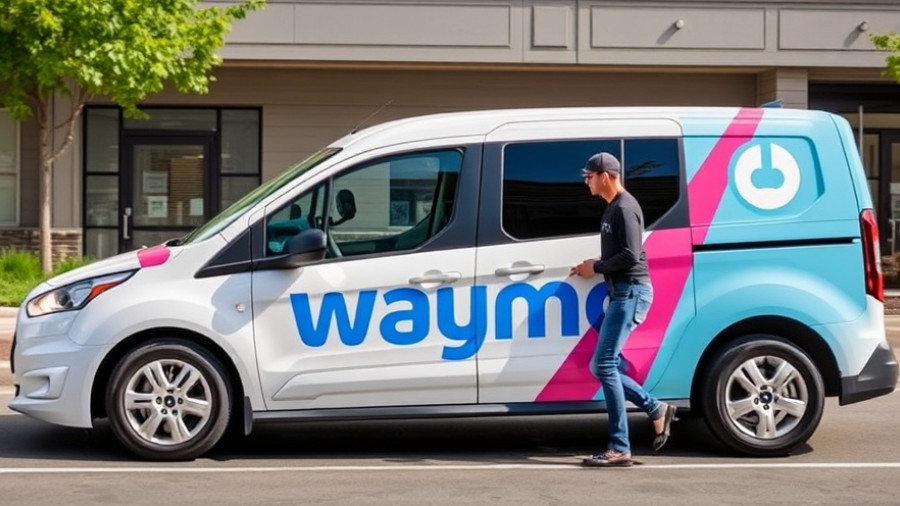
The Rise of Autonomous Deliveries: Waymo and DoorDash Join Forces
As the landscape of food delivery rapidly evolves, Waymo's latest partnership with DoorDash marks a significant step forward in the realm of autonomous logistics. Set against the backdrop of Phoenix—a city known for its embrace of technology—this collaboration demonstrates a compelling fusion of innovation and practicality. Waymo, an Alphabet-owned company, has primarily focused on its well-known robotaxi services but is now venturing into the food delivery market, aligning itself with DoorDash's expansive reach.
Exploring the Mechanics of the Partnership
The two companies are initiating a pilot program that centers around delivering items from DashMart, DoorDash's own convenience store offering. Customers within a 315-square-mile radius of Phoenix can soon expect their food and grocery orders delivered via a self-driving Jaguar I-Pace vehicle, a major step for both companies. As DoorDash's VP of Business and Corporate Development, David Richter, stated, this collaboration “advances our vision for a multimodal autonomous future of local commerce,” showcasing the potential of integrating autonomous technologies into everyday activities.
But how will this service actually work? Customers will need to opt-in for this new delivery method, and once their Waymo vehicle arrives, they will unlock the trunk using the DoorDash app to collect their items. This operational method places the onus on the consumer to retrieve their packages themselves, which could challenge traditional expectations of home delivery services.
Historical Context: Waymo's Journey Through Delivery Innovations
Historically, Waymo has tested various delivery services, previously working with companies like UPS and Uber Eats. However, after re-evaluating its strategy, Waymo shifted its focus toward robotaxis instead of continuing with delivery. This new partnership with DoorDash signals a reinvigorated approach to delivery services, aiming to explore how their autonomous technology can integrate seamlessly into everyday logistics.
Tech and Market Dynamics: Why This Partnership Matters
The necessity for automation in delivery services has become increasingly visible, especially as consumers shift towards more convenience-driven purchasing methods. The implications of this partnership extend beyond the mere provision of groceries; it explores a greater trend of automating local commerce, which other companies like Uber have also pursued. Uber’s collaboration with various delivery robotics companies and their ambitious drone delivery initiatives illustrate this emerging market's dynamism.
Furthermore, DoorDash’s response to market competition indicates a significant investment in technology that aligns with evolving consumer expectations. As these companies obliterate geographical and logistical constraints with autonomous technology, their models may herald future industry standards.
Community Impact: How Will Consumers Respond?
For Phoenix residents, this service seems poised to reshape the way they engage with local commerce. The novelty of receiving groceries from an autonomous vehicle elevates the delivery experience, yet it also brings forth challenges. Will the excitement of new technology outweigh the convenience of a human delivering items to the door? This question remains central as the pilot rolls out, prompting feedback from users as they pilot this autonomous service.
Future Predictions: Autonomous Deliveries as a Market Standard
Looking ahead, the success of this partnership could set a precedent for autonomous delivery systems across the United States. Given its commitment to scaling this service, if DoorDash and Waymo can effectively address consumer hesitance and optimize the experience, we may see autonomous deliveries expand to more cities or even become mainstream across the food and grocery sectors. The implications of successful integration will have ripple effects on urban logistics and delivery paradigms.
Call to Action: Engage with the Future of Delivery
As we witness this innovative partnership unfold, it’s vital for consumers and industry observers alike to provide feedback on their experiences with autonomous delivery. As corporations like Waymo and DoorDash continue to innovate, your insights can help shape the future of delivery logistics, making it smarter and more responsive to consumer needs. Stay informed and be a part of the conversation around the future of autonomous commerce.
 Add Row
Add Row  Add
Add 




Write A Comment